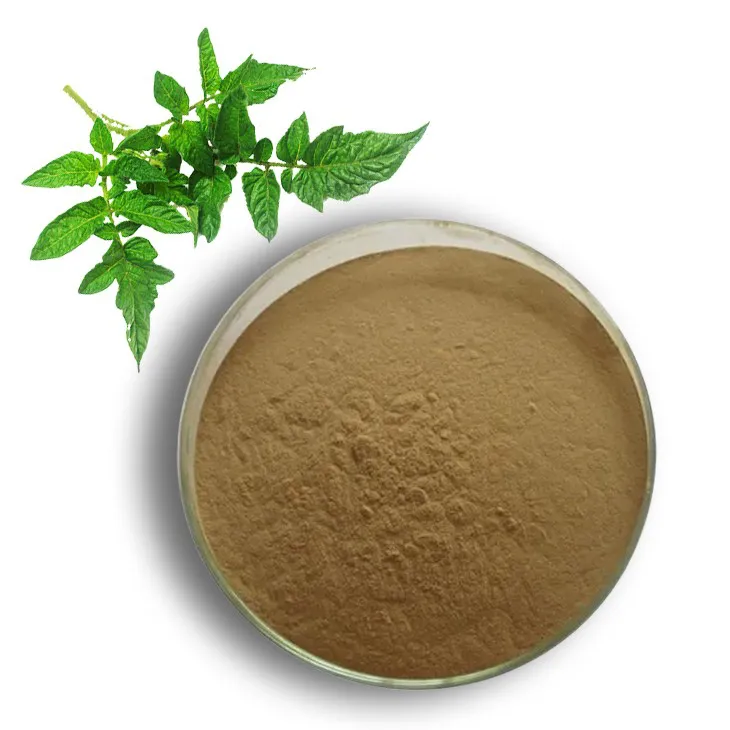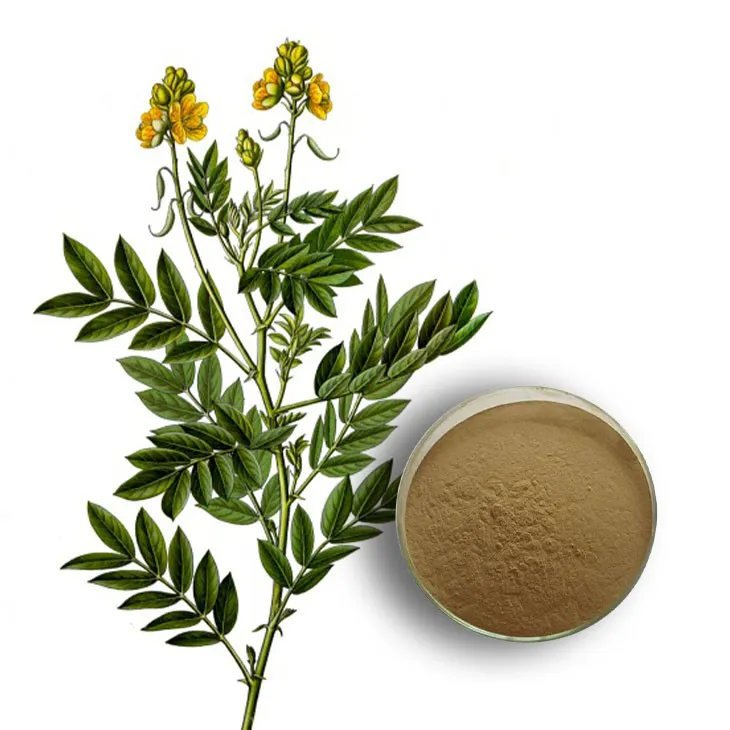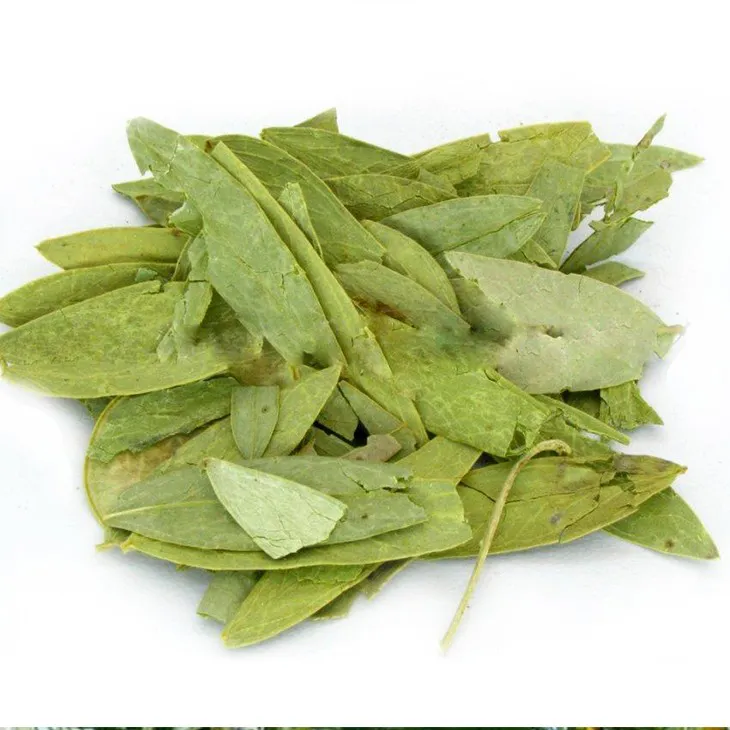- 0086-571-85302990
- sales@greenskybio.com
Extraction Technology and Production Process of Senna Leaf Extract.
2024-11-29

1. Introduction
Senna Leaf Extract has been widely used in various fields, such as in the pharmaceutical and nutraceutical industries. Understanding the extraction technology and production process is crucial for ensuring the quality, safety, and efficacy of the final product. The senna leaf contains a variety of active components, and the extraction method needs to be carefully selected to obtain these components effectively while minimizing the presence of unwanted substances.

2. Extraction Technologies
2.1 Solvent Extraction
- Traditional Solvents: Solvent extraction is one of the most common methods. Ethanol and methanol are often used as solvents. These solvents can dissolve the active components in senna leaves effectively. For example, when using ethanol, the senna leaves are usually soaked in ethanol for a certain period of time. The solubility of the active components in ethanol allows them to be transferred from the solid leaf matrix to the liquid solvent phase. - Advantages and Disadvantages: The advantage of this method is its simplicity and relatively low cost. However, one of the main drawbacks is that it may also extract some unwanted substances along with the active components. Moreover, the solvent needs to be removed completely in the subsequent steps to ensure the safety of the final product. Residual solvents can pose potential health risks if not removed adequately.
2.2 Supercritical Fluid Extraction
- Principle: Supercritical fluid extraction (SFE), especially using supercritical CO2, is an advanced extraction technique. Supercritical CO2 has properties between those of a gas and a liquid. At supercritical conditions (above the critical temperature and pressure), CO2 can penetrate into the matrix of senna leaves and selectively extract the desired components. - Advantages: - Environmentally Friendly: One of the significant advantages of using supercritical CO2 is its environmental friendliness. CO2 is a non - toxic, non - flammable gas, and it does not leave harmful residues in the final extract. - Selective Extraction: It can be tuned to selectively extract specific components from senna leaves. By adjusting the pressure, temperature, and flow rate of the supercritical CO2, different active components can be preferentially extracted. For example, certain flavonoids or anthraquinones in senna leaves can be targeted for extraction. - High - Quality Extract: The extract obtained by supercritical fluid extraction generally has a higher purity compared to solvent extraction methods. This is because it can avoid the co - extraction of a large amount of impurities present in traditional solvents.

3. Production Process
3.1 Pretreatment of Senna Leaves
- Harvesting: The first step in the production process is the proper harvesting of senna leaves. Senna plants are usually harvested at the appropriate growth stage to ensure the maximum content of active components in the leaves. The leaves are carefully collected to avoid damage, which could lead to the degradation of the active components. - Cleaning: After harvesting, the senna leaves need to be thoroughly cleaned to remove dirt, debris, and other foreign materials. This can be achieved by washing the leaves with clean water multiple times. Any remaining contaminants could affect the quality of the extract and may also introduce unwanted substances during the extraction process. - Drying: Drying is an essential step. The cleaned leaves are dried to reduce their moisture content. There are different drying methods such as air drying, oven drying, or freeze - drying. Air drying is a natural and cost - effective method, but it may take a longer time. Oven drying can be carried out at a controlled temperature to speed up the drying process, while freeze - drying can better preserve the active components but is relatively more expensive.
3.2 Extraction
- Solvent Extraction Process: If solvent extraction is used, the dried senna leaves are placed in a suitable extraction vessel. The solvent (such as ethanol) is added in a proper ratio to the leaves. The mixture is then stirred or agitated for a specific period, usually several hours to ensure complete extraction. The temperature can also be controlled during this process to optimize the extraction efficiency. - Supercritical Fluid Extraction Process: In the case of supercritical fluid extraction, the dried senna leaves are placed in the extraction chamber. The supercritical CO2 is pumped into the chamber at the appropriate pressure and temperature. The extraction process is carried out for a certain duration, during which the CO2 continuously circulates through the leaves to extract the active components.
3.3 Purification
- Filtration: After extraction, the extract obtained contains not only the desired active components but also some impurities. Filtration is a common purification step. A filter with an appropriate pore size is used to remove solid particles from the extract. This can be a simple paper filter for larger particles or a membrane filter for finer particles. - Separation of Unwanted Components: In addition to filtration, other separation techniques may be used to remove unwanted components. For example, chromatography can be employed to separate different components based on their chemical properties. This can be particularly useful for separating the active components from closely related substances or impurities.
3.4 Concentration and Drying
- Concentration: The purified extract may still have a relatively high volume of solvent or fluid. Concentration is carried out to reduce the volume and increase the concentration of the active components. This can be achieved by methods such as evaporation under reduced pressure. By reducing the pressure, the solvent can be evaporated at a lower temperature, which helps to preserve the activity of the components. - Drying: Finally, the concentrated extract is dried to obtain a solid or semi - solid form of the Senna Leaf Extract. Spray drying or freeze - drying can be used for this purpose. Spray drying is a fast and efficient method suitable for large - scale production, while freeze - drying can produce a high - quality product with better preservation of the active components.

4. Quality Assessment
- Raw Material Quality: The quality of the senna leaves used as the raw material is the first aspect to be assessed. This includes factors such as the species of the senna plant, the growth conditions, and the presence of any contaminants or pesticides. Only high - quality senna leaves can produce a good - quality extract. - Intermediate Product Quality: During the production process, quality assessment of the intermediate products is carried out at different stages. For example, after extraction, the composition of the extract is analyzed to ensure that the desired active components are present in the appropriate amounts. Any deviation from the expected composition may indicate problems in the extraction process. - Final Product Quality: The final Senna Leaf Extract must meet strict quality standards for safety and efficacy. This includes tests for the presence of residual solvents (if solvent extraction is used), the purity of the active components, and the overall biological activity of the extract. Microbiological tests are also carried out to ensure that the extract is free from harmful microorganisms.
5. Conclusion
The extraction technology and production process of senna leaf extract are complex but crucial for obtaining a high - quality product. Supercritical fluid extraction, especially with supercritical CO2, offers many advantages over traditional solvent extraction methods. The production process involves multiple steps from pretreatment of the senna leaves to final quality assessment. Each step needs to be carefully controlled to ensure that the final senna leaf extract meets the required standards for various applications in the pharmaceutical, nutraceutical, and other industries.
FAQ:
What are the main extraction methods for senna leaf extract?
There are several main extraction methods for senna leaf extract. One common method is solvent extraction, which uses appropriate solvents to dissolve the active components from senna leaves. Another option is supercritical fluid extraction, such as using supercritical CO2 as the extraction medium. Supercritical CO2 extraction has the advantages of being environmentally friendly and being able to target specific components effectively.
Why is supercritical fluid extraction suitable for senna leaf extract?
Supercritical fluid extraction, especially with supercritical CO2, is suitable for senna leaf extract for multiple reasons. Firstly, CO2 is non - toxic, non - flammable, and readily available, which makes it an environmentally friendly choice. Secondly, it can be tuned to have specific solvent properties by adjusting the temperature and pressure. This allows for selective extraction of the desired components from senna leaves while leaving behind unwanted substances to a large extent.
What are the purification steps in the production process of senna leaf extract?
The purification steps in the production process of senna leaf extract may include filtration to remove solid particles. Chromatographic techniques can also be used to separate and purify the target components from other impurities. For example, column chromatography can be applied to isolate the active compounds in senna leaf extract based on their different affinities to the stationary and mobile phases.
How is the quality of senna leaf extract assessed during production?
During the production of senna leaf extract, quality assessment is carried out at different stages. Chemical analysis is used to determine the content of active components, such as sennosides. Physical properties like appearance, solubility, and particle size may also be evaluated. Microbiological tests are performed to ensure that the extract is free from harmful microorganisms. These assessments help to ensure that the final product meets the required standards for safety and efficacy.
What are the factors that can affect the extraction efficiency of senna leaf extract?
Several factors can affect the extraction efficiency of senna leaf extract. The choice of extraction method and solvent (in the case of solvent extraction) is crucial. For example, different solvents may have different solubilities for the active components in senna leaves. In supercritical fluid extraction, the temperature and pressure conditions play a significant role as they determine the properties of the supercritical fluid. The particle size of the senna leaves also affects the extraction efficiency. Smaller particle sizes generally provide a larger surface area for extraction, leading to higher efficiency.
Related literature
- Optimization of Senna Leaf Extract Production: A Comprehensive Review"
- "Advanced Extraction Technologies for Senna Leaf: Current Trends and Future Prospects"
- "Quality Control in Senna Leaf Extract Manufacturing: Best Practices"
- ▶ Hesperidin
- ▶ citrus bioflavonoids
- ▶ plant extract
- ▶ lycopene
- ▶ Diosmin
- ▶ Grape seed extract
- ▶ Sea buckthorn Juice Powder
- ▶ Beetroot powder
- ▶ Hops Extract
- ▶ Artichoke Extract
- ▶ Reishi mushroom extract
- ▶ Astaxanthin
- ▶ Green Tea Extract
- ▶ Curcumin Extract
- ▶ Horse Chestnut Extract
- ▶ Other Problems
- ▶ Boswellia Serrata Extract
- ▶ Resveratrol Extract
- ▶ Marigold Extract
- ▶ Grape Leaf Extract
- ▶ blog3
- ▶ blog4
-
Wholesale Diosmin Suppliers.
2024-11-29
-
100% Organic Carrageenan Extract Powder.
2024-11-29
-
Manufacturers of Fig Extract.
2024-11-29
-
The best organic artichoke leaf extract.
2024-11-29
-
Extraction process of rose hip extract.
2024-11-29
-
The best organic chasteberry extract.
2024-11-29
-
The best sources of natural lily extracts.
2024-11-29
-
Genistein
2024-11-29
-
Withania Somnifera Extract
2024-11-29
-
Reishi mushroom extract
2024-11-29
-
Bilberry Extract
2024-11-29
-
Peppermint Extract Powder
2024-11-29
-
Jujube Extract
2024-11-29
-
Curcuma Longa Extract
2024-11-29
-
Elderberry Extract
2024-11-29
-
Garcinia Cambogia Extract
2024-11-29
-
Red Wine Extract
2024-11-29





















